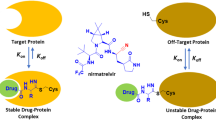Abstract
Real-time measurement of the interaction between DNA-binding drug and target DNA sequence is a subject of interest for drug discovery and development. The effect of long term use of mercurochrome, a mercury containing antiseptic and an active bactericide, on DNA is of considerable importance to explore its toxic effect on human and other living organisms. Although it was banned in USA since 1998, but still it is being used as food preservative and as antiseptic in medicine in many developed and developing countries. Mercurochrome has a flat and planar structure, which may act specifically as intercalator for DNA, resulting in severe side effects and metabolic disorders. In the present work intercalation of mercurochrome with double helical mammalian DNA is studied using computational simulation approach using mercurochrome as ligand and DNA octamer d(GAAGCTTC)2 as a target. This octamer is an oft repeat sequence of CT-DNA and its complex with Actinomycin has been taken from Protein Data Base. The study suggests that mercurochrome acts as intercalating agent by participation of hydrogen bonds with guanine and cytosine. The findings of computational study are also validated by using fluorescence spectroscopy and gel electrophoresis on CT-DNA-mercurochrome adduct.






Similar content being viewed by others
References
Federal Food, Drug, and Cosmetic Act (FD&C Act) (2009) Quantitative and qualitative analysis of mercury compounds in the list. U.S. Food and Drug Administration. 04–30
Mohite PN, Bhatnagar AM (2009) Mercurochrome 1% as an antiseptic for burns: economical—but is it efficacious and safe? Internet J Surg 21(2). doi:10.5580/917
Cleveland DE (1931) Mercurialism from the external use of mercurochrome—220 soluble. Can Med Assoc J 24:272–273
Corrales TJL, De Corres F (1985) Anaphylactic hypersensitivity to mercurochrome (merbrominum). Ann Allergy 54:230–232
Dubey SK, Misra K, Tiwari A, Bajaj AK (2006) Chemically induced pigmentary changes of human skin, interaction of some azo dyes with human DNA. J Pharmacol Toxicol 1:234–247
Dubey SK, Pandey A, Bajaj AK, Misra K (2007) Some commercial azo dyes as inhibitors of mushroom tyrosinase DOPA oxidase activity. J Pharmacol Toxicol 2:718–724
Bharali MK, Dutta K (2009) Hepatic histopathological abnormalities in rats treated topically with para-phenylene diamine (PPD). J Pharmacol Toxicol 4:221–228
Gato WE, Means JC (2011) Exploring transcriptional relationships within fisher-344 rats exposed to 2-aminoanthracene using VisANT network modeling and gene ontology tools. J Pharmacol Toxicol 6:234–248
Watson R, Bauer WR (1977) The viscometric behavior of native and relaxed closed circular PM2 DNAs at intermediate and high ethidium bromide concentrations. Biopolymer 16:1343–1356
Lui LF, Wang JC (1975) On the degree of unwinding of the DNA helix by ethidium. II. Studies by electron microscopy. Biochim Biophys Acta 395:401–412
Keller W (1975) Determination of the number of superhelical turns in simian virus 40 DNA by gel electrophoresis. PNAS 72:4876–4880
Blake A, Peacocke AR (1968) The interaction of aminoacridines with nucleic acids. Biopolymers 6:1225–1253
Patel DJ (1979) Nuclear magnetic resonance studies of drug-nucleic acid interactions at the synthetic DNA level in solution. Acc Chem Res 12:118–125
Peacocke AR, Skerette JNH (1956) The interaction of aminoacridines with nucleic acids. Trans Farady Soc 52:261–279
Waring MJ (1965) Drugs which affect the Structure and Function of DNA. Nature 219:1320–1325
Müller W, Crothers DM (1968) Studies of binding of actinomycin and related compounds to DNA J. Mol Biol 35:51–290
Armstrong RW, Kurucsev T, Strauss UP (1970) The interaction between acridine dyes and deoxyribonucleic acid. J Am Chem Soc 92:174–3181
McDonnell G, Russell AD (1999) Antiseptic and Disinfectants: Activity, Action, and Resistance. Clin Microbiol Rev 12:147–179
Rose PW, Beran B, Bi C, Bluhm WF, Dimitropoulos D, Goodsell DS, Prlić A, Quesada M, Quinn GB, Westbrook JD, Young J, Yukich B, Zardecki C, Berman HM, Bourne PE (2010) The RCSB protein data bank: redesigned web site and web services. Nucleic Acids Res 39(Database issue):D392–D401
Good AC, Oprea TI (2008) Optimization of CAMD techniques 3. Virtual screening enrichment studies: a help or hindrance to tool selection? J Comput Aided Mol Des 22:169–178
Morris GM, Goodsell DS, Halliday RS, Huey R, Hart WE, Belew RK, Olson AJ (1998) Automated docking using a Lamarckian genetic algorithm and empirical binding free energy function. J Comp Chem 19:1639–1662
Sanner MF (1999) Python: a programming language for software integration and development. J Mol Graph Model 17:57–61
Acknowledgments
One of the authors (RKK) greatly acknowledges the Director, IIIT, Allahabad for providing necessary facilities and financial support for doing in silico study.
Author information
Authors and Affiliations
Corresponding author
Rights and permissions
About this article
Cite this article
Sethi, R., Kesharwani, R.K., Haroon, S. et al. Study of Mechanism of Interaction of Mercurochrome with CT-DNA by Computation, Fluorescence and Electrophoretic Methods. Proc. Natl. Acad. Sci., India, Sect. A Phys. Sci. 83, 97–103 (2013). https://doi.org/10.1007/s40010-013-0086-4
Received:
Revised:
Accepted:
Published:
Issue Date:
DOI: https://doi.org/10.1007/s40010-013-0086-4




